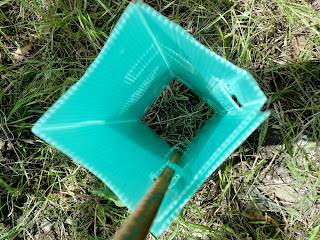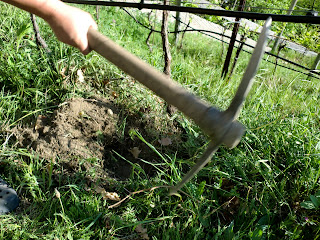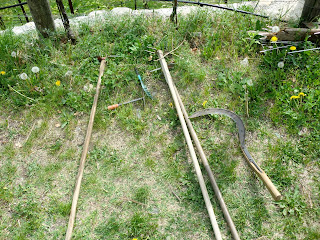This past week the weather has been cloudy and rainy. It all started the Sunday the students came back. Because of this, I was not able to take my camera out with me, because I was afraid it may get wet and ruined. The pictures in this post are all from one sunny day. I will also list a few other things I did but could not
document.
Nik wanted to spread some nitrogen fertilizer throughout the vineyard. This could only be done when it is raining to allow the fertilizer to dissolve quickly. As I stated before, it has been raining all week, so we took a day to spread the fertilizer. All plants need to nitrogen to grow and prosper. This is true for a plant in the depths of the ocean or a tree right below the timber line, they need nitrogen. On planet earth, there are 3 ways that nitrogen occurs naturally. Nitrogen is all around us and has been here for billions of years. It is in the soil and the air. Nitrogen is also created when lightning strikes an area. The super heated bolt combine certain atoms to form nitrogen. The last way nitrogen is made naturally, is with the help of rhizobium bacteria. These bacteria form symbolic relationships with legumes (clover or soy) and form nitrogen. To go into more detail about these processes, would take up a post of it own, so I will keep simple.
The chemical fertilizer that we used was created in a factory with a lot of energy input, usually from oil. Once the nitrogen is applied to the ground, it dissolves. The nitrogen naturally stimulates the plants and gives them a boost in growth. This is especially needed for the older vines because they have depleted the soil around them.
The next task also had to be done with all of the vines. We had to go to each vine and take away all of the unwanted leaves. This meant taking off any leaf that was under a certain spot on the plant. You would simply take your hand and place it under the 2nd wire and anything below your hand could be cut off. This allows for the vine to put all of it's energy into the top portion, causing the plant to grow upwards. If there are two vines growing out of one vine, you also take the weaker one off.

Vine before pruning

The unwanted stem

Break off

The 2nd wire, everything below goes
Double eye
I also did a lot of seeding around the whole farm where needed. I used grass seed to help green up some spots that were simply dirt. The grass will provide food for the animals to eat but also slow down erosion, which is important because farms can lose a lot of dirt in these areas.
Supplies

Grass seed

Hard to see but the grass seed being thrown

Where I had to seed

Seeds on the ground
The drains pictured below are scattered all around the farm and allow water to drain. Although most of the rain will flow downward, it is better to keep the flow concentrated. This will allow less erosion because all of the water is funneled into a few spots. These drains tend to get clogged with debris and soil, some of them have not been cleaned all winter. Plants were starting to grow out of them. This job will have to be done periodically, usually after heavy thunderstorms.
Two weeks ago I planted some new vines to replace the old dead ones. This week I gave them some protection. I went down to the Gold Muskatellers with a hammer, rebar, plastic boxes and metal clips. The plastic boxes are put around the vine for physical protection from the weed wacker but also creates a small greenhouse affect that will help the plant grow.

The supplies
Metal clip used to attached rebar to wire
It is also important to weed around the new vine before placing the box down
Unweeded

Weeded

Old zinc poles were used to guide the vine, so I removed these and replaced with rebar
The old zinc rod still by the new plant

Box, with holes to allow rebar to go through

The fold that keeps the box together
It's hammer time
Looking down into the box
Close up of the vine in the box
Here is a video I took putting one of those boxes together. I realized after viewing the video it may have been better to talk and explain what I was doing but that did not happen. Hope you all enjoy






































